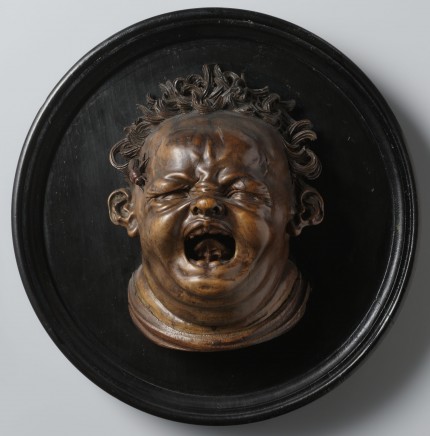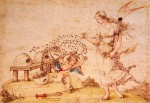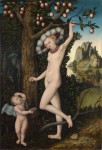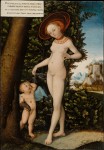Amsterdam’s Rijksmuseum has received a most wonderful gift from an anonymous donor: the spectacularly expressive head of a screaming baby carved in wood by Dutch Renaissance sculptor and architect Hendrick de Keyser in around 1615. De Keyser was known for his realism — even including less than flattering aspects like a client’s wrinkles on his sculptures — and for his intense, dynamic expressions.

Although you may think he sat behind you once in an airplane, this screaming baby is actually a god. Click on the embedded picture to see it in high resolution. There’s a large bee on the left temple.
It’s a representation of Idyll XIX – The Honey Thief, a classical Greek poem attributed to 3rd century B.C. bucolic poet Theocritus but probably not actually written by him. Naughty Cupid tries to steal some honey from a hive only to get stung by one of its denizens. Wailing and crying and stamping his little feet, he runs to his mother Venus to complain about the agony inflicted upon him by such a small creature. Venus points out that he’s just like the bee: he’s little but can inflict immense pain with his love arrows.
 The story of Cupid and the bee became a popular theme in Renaissance Northern Europe. Albrecht Dürer was the first to tackle the subject with Cupid the Honey Thief, painted in 1514 as part of a series of watercolors on classical mythology.
The story of Cupid and the bee became a popular theme in Renaissance Northern Europe. Albrecht Dürer was the first to tackle the subject with Cupid the Honey Thief, painted in 1514 as part of a series of watercolors on classical mythology.  Hot on his heels was Lucas Cranach the Elder who in 1525 painted Cupid Complaining to Venus, now in London’s National Gallery. He and his workshop would produce close to 30 paintings on this same theme.
Hot on his heels was Lucas Cranach the Elder who in 1525 painted Cupid Complaining to Venus, now in London’s National Gallery. He and his workshop would produce close to 30 paintings on this same theme.
 I particularly like a version in the Metropolitan Museum of Art, Venus with Cupid the Honey Thief (1530), because of Venus’ excellent hat and the hilariously transparent “modesty” veil she coyly drapes over her crotch. The Met’s Cranach also has a Latin inscription on the upper left which explains the crux of the theme’s appeal to dour northern cultures: “As Cupid was stealing honey from the hive / A bee stung the thief on the finger / And so do we seek transitory and dangerous pleasures / That are mixed with sadness and bring us pain.”
I particularly like a version in the Metropolitan Museum of Art, Venus with Cupid the Honey Thief (1530), because of Venus’ excellent hat and the hilariously transparent “modesty” veil she coyly drapes over her crotch. The Met’s Cranach also has a Latin inscription on the upper left which explains the crux of the theme’s appeal to dour northern cultures: “As Cupid was stealing honey from the hive / A bee stung the thief on the finger / And so do we seek transitory and dangerous pleasures / That are mixed with sadness and bring us pain.”
Hendrick de Keyser’s sculpture stands out from the work of his earlier colleagues for its committed expressiveness and realism. Neither Dürer’s nor Cranach’s Cupids look anything like so perturbed. That wide open screaming mouth with just one little tooth makes Cupid into a literal mid-tantrum baby, rather than a cranky deity in child form. Compare it to de Keyser’s very similar bronze Bust of a Crying Child also made around 1615 which is now at the Los Angeles County Museum of Art (although sadly not on display). The expressions are nearly identical, but the bronze bust has no bee and thus no Cupid allusion.
The Rijksmuseum is currently undergoing extensive renovations. When it reopens in 2013, Screaming Child will be put on display along with their handful of other exceptional Hendrick de Keyser sculptures.